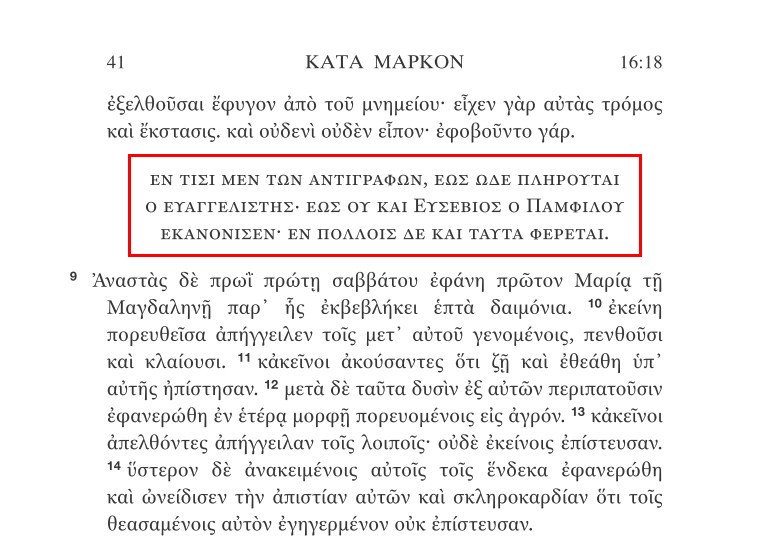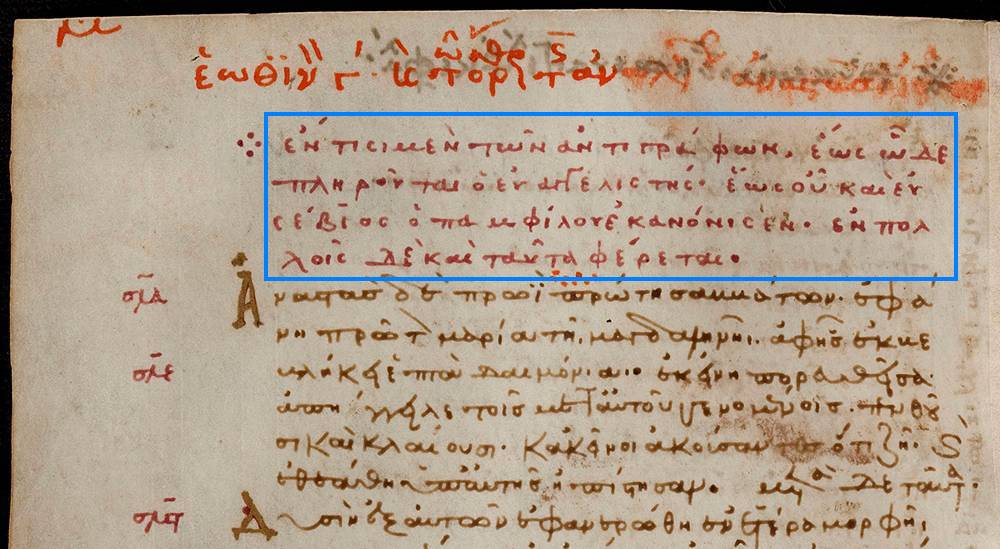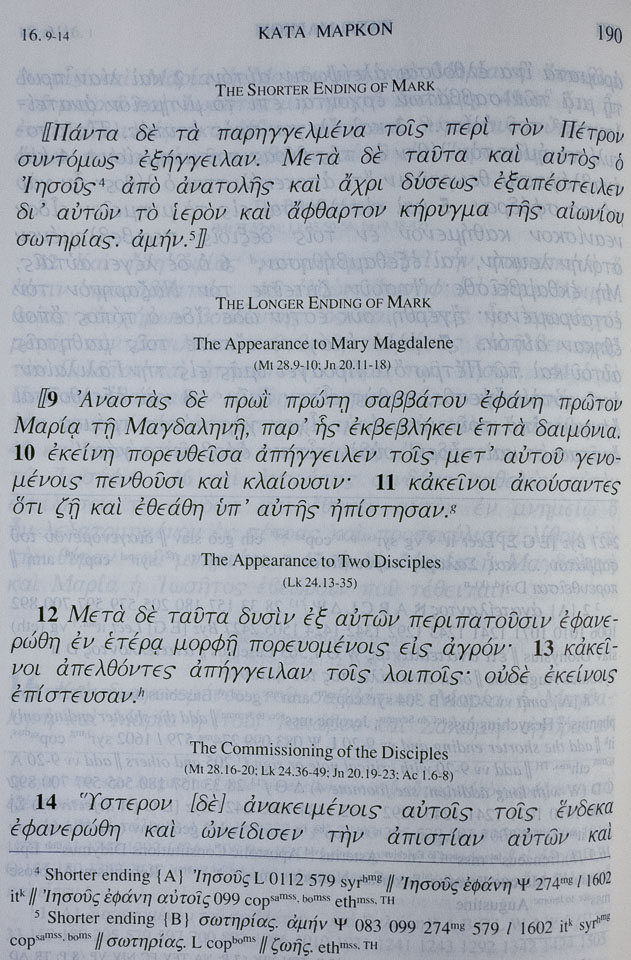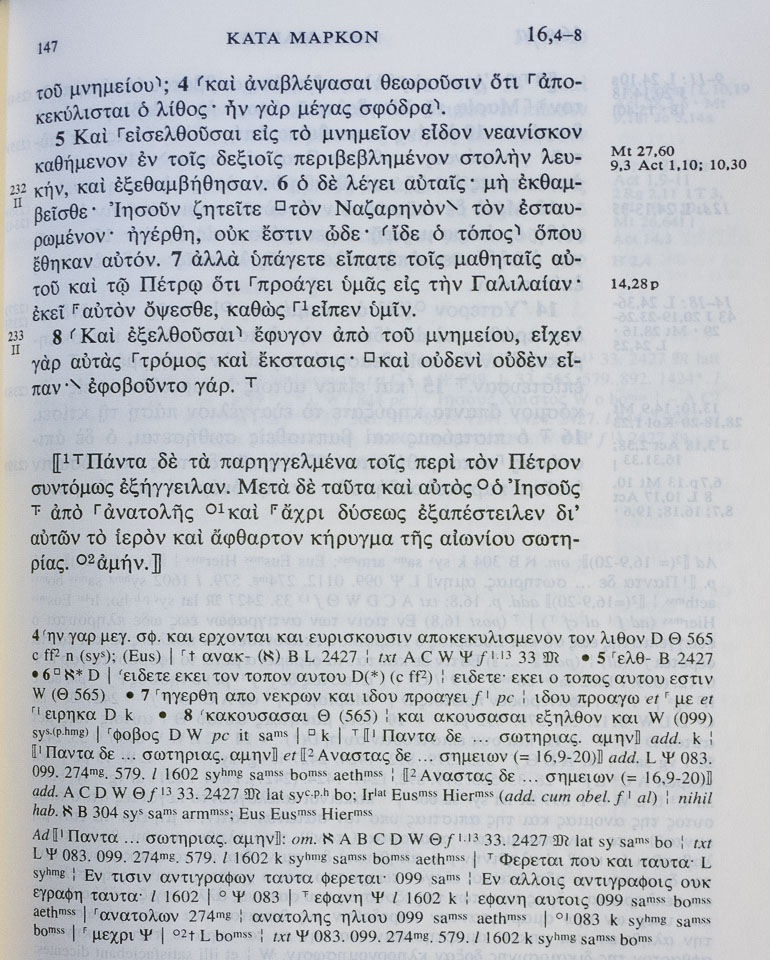I’ve been reading through the New Testament in Greek recently from The Greek New Testament, Produced at Tyndale House, Cambridge (THGNT) pictured above. Anyone who knows me knows that I appreciate good Bible design, and the THGNT comes the closest yet to the perfect Greek New Testament that I’ve seen. But that’s the subject of another post. 🙂
Anyway, as I was reading along, I came to Chapter 16 of Mark, and noticed a rather unique insertion into the text at the end of Mark 16:8 (framed in red below).

Clearly that’s not part of the original text, so what is it? Just in case you’re having trouble reading Greek in ALL CAPS, here’s a regular version:
ἔν τισι μὲν τῶν ἀντιγράφων, ἕως ὧδε πληροῦται ὁ εὐαγγελιστής∙ ἕως οὗ καὶ Εὐσέβιος ὁ Παμφίλου ἐκανόνισεν· ἐν πολλοῖς δὲ καὶ ταῦτα φέρεται.
In some of the copies, the evangelist finishes here, up to which (point) also Eusebius of Pamphilus made canon sections. But in many the following is also contained.
(English translation from the THGNT’s apparatus)
It looks like a scribal note about the ending of Mark which the THGNT editors decided to include in their edition of the Greek NT as an explanation (or preface) to the longer ending! If we look down in the THGNT apparatus for Mark 16:8, we find an explanation of the source: “note as found in minuscule 1“.
Well, that piqued my interest, so I did a little online sleuthing, and found some digital images of miniscule 1 (GA #30001). There’s the note, right at the top of the page! (I added a blue box around it for clarity).

Fascinating stuff! I love any excuse to look at old biblical manuscripts. 🙂
I would dearly love to have heard the discussions that the THGNT committee had about this passage, and what it was that eventually sold them on the idea to include a scribal note from a 12th century manuscript!
Whatever the case, I rather like the idea of using an ancient explanatory note found in a biblical manuscript, rather than the terse heading: “THE LONGER ENDING OF MARK” that you’ll find in the UBS4:

Or the even more cryptic markings in the apparatus of the NA27.

Some of the THGNT’s other claims to fame include some rather unique ancient spellings (“γεινώσκετε” anyone?), and its preservation of the ancient method for paragraphing (outdenting the first line instead of indenting, see the first image in this post). But I think my favorite “quirk” of the THGNT is that neat little note from the scribe of miniscule 1!
Resources on Mark 16:9-20
Here are some relevant resources on the “longer ending” of Mark that I’ve come across. Thanks to those who commented below with links to additional resources!
- Samuel Tregelles on Mark 16:9-20 from An Account of the Printed Text of the Greek New Testament, pg. 246-261. (Read a text version with commentary here. As Matthew pointed out in the comments, the THGNT is based on Tregelles’ Greek NT).
- E. W. Bullinger’s The Companion Bible – Appendix 168: “The Last Twelve Verses of Mark’s Gospel” (Read a text version here.)
- MARK16 – A virtual research environment for the last chapter of Mark, including:
- Manuscript evidence (with digital images of the manuscripts)
- Open Access Publications (a long list of research articles and chapters from books)
- Open Access Multimedia (video and audio)
- James Snapp Jr’s page: “Resources For the Study of Mark 16:9-20“.


Interesting note about an old phenomenon. I wish the TH editors had put it into smaller type, as a note, rather than to make it all-caps, as if it’s more important than the surrounding Bible text.
Since the THGNT started with the text of Samuel Tregelles, it might be appropriate to read his 1834 conclusion about these verses https://www.thetextofthegospels.com/2022/01/samuel-tregelles-and-mark-169-20.html .
There is evidence for the longer ending as far back as AD 200, referred to by Irenaeus (202), Tertullian (220), and Hippolytus (235). On the other hand, the abrupt ending also has early evidence, possibly as far back as Origen in AD 253. Tregelles might have been pretty close to the mark, and perhaps right on it, when he compared the last 12 verses of Mark 16 with the last chapter of Deuteronomy.
Good points, Matthew. I agree that making it look a bit more like a “note” rather than a heading would have been helpful. Thanks for the link to Samuel Tregelles’ thoughts on Mark 16:9-20! Here’s a link directly to an online copy of the print book for anyone else who may be interested in reading it: https://archive.org/details/anaccountofthepr00treguoft/page/246/mode/2up
This whole issue is quite the fascinating (and sometimes polarizing) discussion! I bookmarked this summary of the topic a while back when I came across it: https://www.therain.org/appendixes/app168.html I don’t necessarily endorse this site or its views, but it seems to be a reasonable look at the evidence. Another resource I just came across more recently is https://mark16.sib.swiss/, which has a wealth of materials, including mss evidence and a long list of articles and books, as well as videos on the topic. Another page that gathers a lot of resources together in one place is James Snapp Jr’s page on Mark 16.
Thanks for those links! The first link in the second paragraph seems to be a page from E. W. Bullinger’s Companion Bible, so it should be fairly factual–though maybe out of date–even if the rest of the website may or may not be as sound.
Thanks for your contributions! I’ve updated the post with a new section containing some of these resources that were mentioned here in the comments.
Neat! Thanks!